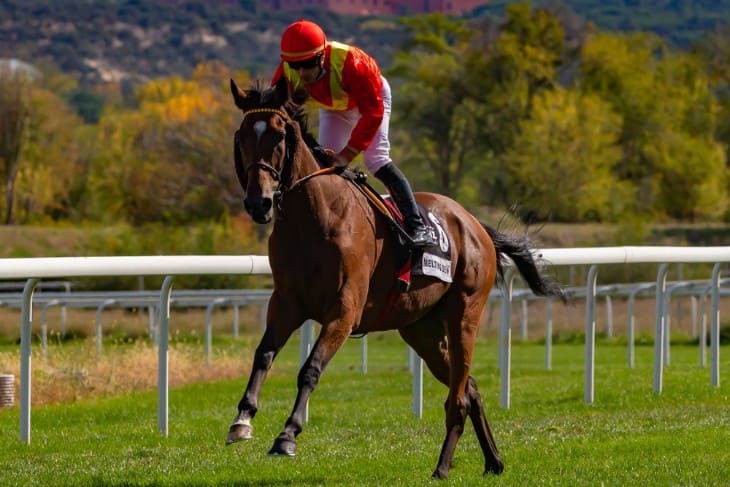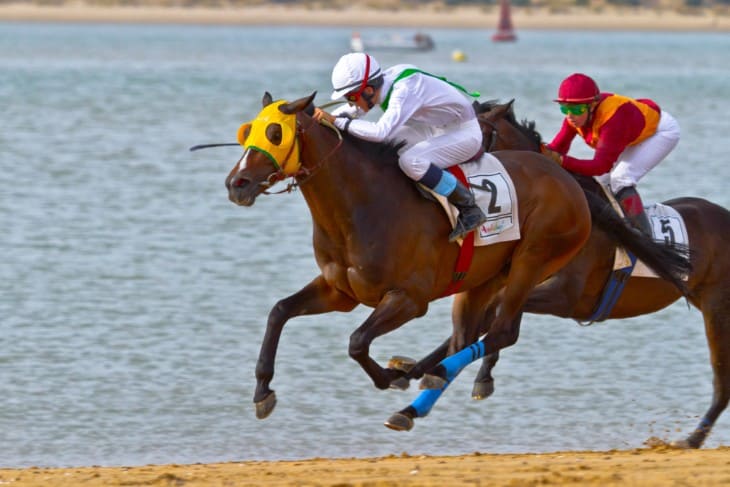- The Root Causes of Box Walking in Horses
- The Effects of Box Walking on Racing Performance
- Spotting the Tell-Tale Signs of Box Walking in Your Horse
- Environmental Enrichment: Its Role in Preventing Box Walking
- Training and Management Strategies to Reduce Box Walking
- The Importance of Social Interaction in Combating Box Walking
- How Nutrition Influences Box Walking in Horses
- Conclusion
Box walking, pacing around in a box or along stall walls, is a significant concern for the equine community, especially in horse racing. This guide examines why horses engage in box walking and provides essential tips on managing this harmful behaviour for trainers, owners, and enthusiasts who want to ensure their equine athletes are happy and healthy.
The Root Causes of Box Walking in Horses
A few main things may cause box walking. Understanding these will help us address the problem more effectively.
- Stress: This means that horses might start box walking, just like we do if stressed out. It can happen if they become lonely or their daily routine changes drastically. Keeping their day-to-day life consistent and ensuring they have company can reduce stress.
- Boredom: A horse can develop boxwalking due to boredom. Horses need something to keep them busy and things to look at. When confined without any mental stimulation, horses will try different activities to kill time, such as boxwalking. Giving them toys or changing their environment to make it more interesting can help keep boredom at bay.
- Lack Of Exercise: More exercise! That is why, often, one finds horses circling inside their boxes when there is not enough movement. This may be done by encouraging them to stay within their stalls and providing enough time for running and playing outside.
- Need For Social Interaction: They like spending time with other horses since they are social animals. They walk around their boxes if they feel isolated by doing this. Letting them see and interact with other horses meets this need, making it unnecessary for them to move inside boxes so much.
Addressing these causes will help prevent some cases of horsebox walking. Every animal has its peculiarities, so different approaches may be needed to find what works best for a particular horse.
The Effects of Box Walking on Racing Performance
Box walking can be detrimental to a racehorse's performance in various ways. Firstly, it takes up time and energy that could have been put into training or racing. Think about how tired you would be if you walked in circles all day. Therefore, the horse may not have enough energy left when it counts- at the track.
Secondly, this action causes stress and anxiety. A stressed horse will not focus well during training or races. They might be more jittery or nervous, making listening to their jockey's commands harder. Their lack of concentration could cost them a win.
Box walking also leads to other physical problems, such as joint issues from constant walking on hard surfaces and uneven wear on hooves. If not appropriately treated, box walking ultimately results in the horse being uncomfortable and even lame. A physically compromised horse cannot excel in races.
Lastly, repetitive box walking may indicate that there are deeper mental health problems involved here. Like with people, a horse's mental health affects its overall performance. Consequently, a happy, average equine is likelier to do well as it participates in races than one that isn't mentally stable.
Box walking can be more than a weird habit; it is a severe issue that could influence a horse's racing career. It can drain energy, lead to stress, cause physical harm, and symbolise mental disorders. Dealing with box walking is essential for maintaining race horses' optimal performance.

Spotting the Tell-Tale Signs of Box Walking in Your Horse
Being able to see box walking early enough helps you stop it from becoming a significant problem. Here are some signs that you should look out for:
- Restlessness: An anxious horse beginning to box walk usually restlessly walks back and forth or stands still. Restlessness may indicate that the horse is feeling stressed or bored, which initiates it to start walking in circles
- Repetitive Walking Patterns: The most visible sign is how your horse walks around its stable space. If your horse repetitively walks in circles or down an aisle of its stall, this is clear evidence of box-walking. This conduct becomes particularly conspicuous unless there is apparent motivation, like reaching for food or water.
- Visible Wear in Bedding or Flooring: Over time, as the path they follow along their walk wears out the bedding or floor lining in their stall, a horse that suffers from box walking would show it. Such a path looks like a lane running through the stalls that tend to be more worn out than other stall parts. This sign signifies that your horse has been doing this behaviour over time.
- Changes in Behaviour or Mood: Sometimes, these indications are less obvious; however, horses who walk around boxes may exhibit specific personality changes and mood swings. For example, a moody animal may get grumpy and lose interest in food when it undergoes such behaviour modification, unlike before when it remained calm and unaffected by anything else happening around it. These alterations represent negative signals.
Early recognition of these symptoms can help your mare deal with them accordingly. If you notice any of them, then it is high time you should check the environment of your horse or its regular activity. This means that if you decide to change certain aspects about your horse, it might help it feel better and eventually stop box walking.
Environmental Enrichment: Its Role in Preventing Box Walking
Making a horse's life more interesting can be an effective way to prevent box walking. Horses are less likely to walk around in circles because they are not bored or stressed when they have something to do. If you were stuck in an empty room all day, you would start looking for busy work to keep your mind occupied, and the same goes for horses.
Firstly, placing toys within their stalls can make a significant difference. Many toys designed for horses can always keep them alert, thus making their stables more exciting. Even just hanging up balls for them to push around is helpful enough.
Another critical aspect of environmental enrichment is allowing horses free access out of their stalls for some time during the day. Not only humans but also horses find it very dull being locked up all day long. It allows them to move around and explore new things outside rather than staying indoors, like paddocks or fields where they can eat grass, gallop, or play with each other.
Moreover, social interaction is also essential. Horses are social creatures; therefore, they must spend time with other horses. This can be as simple as ensuring they can see and touch other horses or even being within the same stall. Some stables even have bars between stalls so the horses can interact without being in the same place.
Finally, change up their routine; this will keep it interesting for your horse. The more a horse does one thing daily, the less interested he becomes in it. To keep their minds engrossed, new training exercises, new turnout times, and walking them differently could be tried.
If these aspects of environmental enrichment are focused upon, then a horse's life can become more exciting and decrease the chances of starting box-walking. It's all about keeping their minds and bodies active and engaged.
Training and Management Strategies to Reduce Box Walking
There are several ways to reduce and manage box walking among equines through training and caring for them. Here's how:
- Consistent Routine: Horses thrive on routine. Consistent feeding, turning out, and exercise schedules can help reduce their stress levels. They feel more secure if they know what will happen at any given time, hence reducing their chances of engaging in box-walking behaviours.
- Positive Reinforcement: To encourage calm behaviour, you must use a positive reinforcement strategy. This means that once your horse stays still without moving around, it should be rewarded since rewards reinforce behaviour one wants to see happen again. Normally, treats, gentle patting, or kind words work perfectly.
- Increased Turnout Time: More time outside their stalls equals less box walking time. Horses love moving around naturally. Allowing them extra freedom, like having more places where they move freely, graze around, and meet others, consequently reduces the number of new circles or rounds of walking.
- Mental Stimulation: Let your horse's mind get occupied. Mentally challenging training exercises are good for them. This may include obstacle courses, new tricks, training sessions, etc. Horses become mentally stimulated and thus can be less likely to engage in such repetitive behaviour as box-walking.
- Social Interaction: Ensuring your horse has plenty of opportunities for social interaction can help. Social contact with others can reduce the likelihood of his feeling isolated and help him start pacing.
- Relaxation Techniques: If your horse is a box walker, you can try teaching him relaxation techniques. Massage could be one technique to calm him down, or sometimes a gentle brushing or even soft music could be played around his stall. Behavior Techniques That Can Help
Carrying out these strategies requires patience and consistency. It takes time, but over time, these practices will go a long way toward improving the animal's life by reducing, if not eliminating, box walking.

The Importance of Social Interaction in Combating Box Walking
Social interaction is essential when it comes to horse fighting and box walking. These animals are social and gain a lot from being near their kind naturally. This way, they will feel safe and, therefore, will only perform the habit of box walking a little.
Horses need companionship just like people do. They can suffer from loneliness if left alone for long periods. When allowed to interact with other horses, they exhibit normal behaviours such as mutual grooming, which makes the horse more settled and secure. This sense of security is crucial in preventing stress-related behaviours like box walking.
Moreover, living in groups allows them to be themselves socially and naturally. They can play together, talk to each other, and establish hierarchies among themselves, which are vital for their mental health. Such involvement takes away boredom and anger that prompt box walking.
Additionally, socialising results in physical activity for horses. Horses tend to spend more time playing or moving around with others than those without friends, hence burning excessive energy that could otherwise go into box walking. This physical exercise is as essential for their mental health as it is for their physical wellbeing.
Finally, regular positive social interactions also reduce a horse's chances of suffering from stress-related actions. Horses that feel integrated into society generally have better moods, which best suits their well-being and behaviour.
Encouraging interconnection among horses helps decrease box walking; this provides emotional support and physical activities that address its root causes, like stress and boredom. Thus, the horse's environment becomes more natural, leaving them fulfilled, thus reducing the frequency of instances where a horse walks in circles.
How Nutrition Influences Box Walking in Horses
Nutrition plays a significant role in boxing by influencing horses' behaviour. The type of food they eat affects how they act, feel, and function generally within their bodies.' Proper diets can prevent box walking by ensuring horses are physically and mentally fit.
First, a horse's diet high in sugar or starch may make it more energetic, anxious, or hyperactive, leading to box walking. Sugar or starch acts as energy, which horses cannot burn quickly when confined to a stall. Maintaining an appropriate diet suitable for their activity level will avoid fluctuations in energy levels, reducing stress-related behaviours.
Also, some nutrient deficiencies can enhance stress and anxiety symptoms in horses. For instance, magnesium plays a role in the functioning of muscles and the health of the nervous system. With an inadequate supply of magnesium in its diet, a horse might be prone to stress, which may cause it to walk around the stable indefinitely. Their whole-system well-being needs to have all minerals and vitamins in food.
Fibre also influences box walking as part of the horse's diet. Due to its richness in fibre, horses spend most of their time feeding on hay; this behaviour encourages natural foraging instincts and can keep the horse occupied for longer hours at pasture. Thus, it aids digestion while eliminating boredom, which is often one reason why a horse walks round and round upon itself.
In addition, the frequency at which horses are fed can also impact their behaviour. Horses are grazing animals, and being able to eat constantly can imitate this, reducing stress and the possibility that they may start pacing. If you provide small amounts of food for them often rather than giving them a few large meals, this will make them feel more satisfied and occupied.
Nutrition plays a vital role in managing box-walking horses. A well-balanced and suitable diet can help keep their energy levels constant, meet their dietary requirements, and alleviate boredom, thereby minimising box-walking tendencies.
Conclusion
Box walking in horses is a complex behaviour requiring multi-faceted management and prevention strategies. Understanding its origins, recognizing how it affects performance, and implementing appropriate enrichment programs, training, and care approaches would improve life quality for equine athletes while ensuring their welfare and success in sport horse racing at a competitive level.







